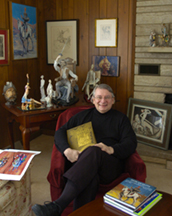
| AUDIO |
| • Howard Mancing, professor of Spanish, talks about the novel "Don Quixote." (44 seconds) |
| RELATED INFO |
| • Sample of Don Quixote terms from Mancing's "The Cervantes Encyclopedia" |
| • Howard Mancing |
February 9, 2005
Man of la Mancha celebrates 400 years in 2005
WEST LAFAYETTE, Ind. – Don Quixote made his name jousting with windmills 400 years ago, but now this iconic literary figure's greatest fight will be conquering an electronic world dominated by video games and fewer fans of long novels, says a Purdue University Don Quixote expert.

|
Howard Mancing, professor of Spanish, thinks the idealistic old knight-errant will win.
"For four centuries this character has not only lasted but also influenced many artists, writers, musicians, poets and film directors," said Mancing, who is author of "The Chivalric World of Don Quixote" and "The Cervantes Encyclopedia."
"'Don Quixote' is required reading in Spain and other European countries, and even though fewer young Americans are willing to read this book on their own, I think the story and characters are significantly rooted in our contemporary literature and art.
"However, we should still be concerned that this great novel is being read by fewer people themselves."
This year marks the global celebration of the book's 400th birthday. Miguel de Cervantes published Part One of "Don Quixote" in 1605, and the book was so well received it was published six more times that year. In 2002, an international survey showed that "Don Quixote," which is believed to be the first novel, is recognized as the best work of fiction ever written.
"It's a great work, but if you read the book yourself, you are likely to struggle," Mancing said. "In the age of video — film television, computer screens and video games — Americans generally don't read such complex literary works. Certainly, many more people begin this book than finish it. If reading this book on your own, it helps to talk with someone who has read the novel."
Within months of the book's publication in Spain, "Don Quixote" became part of England's popular culture, Mancing said. Part II was published in 1615, and the entire novel was the most-read work of fiction in Europe in the 17th and 18th centuries.
"Did Cervantes realize he was writing a novel? No, probably not," Mancing said. "I think he started writing something that he thought would entertain. But as he was writing, he got caught up in the story, and it evolved into something else."
The author's prologue mentions four times that his aim is to criticize the romance of chivalry, which was a popular theme in the 17th century.
"I don't think there has been a book rewritten, adapted, updated and reanimated the way this one has," Mancing said. "Even one of the novel's most minor characters, Dulcinea de Toboso, is still given a tremendous amount of attention today, even though she is the most significant absent character in literature."
Dulcinea del Toboso, the peasant whom Don Quixote devotes his adventures to, never appears in "Don Quixote," but she is constantly talked about and is at the center of Don Quixote's notions of romantic chivalry.
Mancing's "The Cervantes Encyclopedia" is the first-of-its-kind resource written in English. The two-volume set lists characters, geography, terms, and interpretations, such as connecting the novel with more contemporary social issues, such as gender and racism. The novel also has influenced Charles Dickens, Jane Austen, Pablo Picasso, William Faulkner, Mikhail M. Bakhtin and even Woody Allen.
William Shakespeare not only read "Don Quixote," but he also adapted one episode from the first part of the novel for one of his plays that was only performed in the royal palace, Mancing said. Now, it is believed that "Cardenio," which was thought to be lost, is the basis of "The Second Maiden's Tragedy," the collaborative work generally credited to Shakespeare and his contemporary, John Fletcher. Since the original version, a variety of English writers have revised the play.
Cervantes, born in 1547, and Shakespeare, born in 1552, both died on April 23, 1616. However, they really died 10 days apart because England was still using the old Julian calendar, while Spain had already adopted the corrected Gregorian calendar.
In Spain, April 23 is known as the "Dia del libro," Day of the Book, and April 23 is often celebrated with a variety of literary activities, such as marathon readings of the 126-chapter book.
"People love the story because of the absurdity, combined with the nobility of Don Quixote, and the characters, especially Don Quixote and Sancho Panza," Mancing said. "Many people can relate to their realism and idealism. Plus, the idea that life should be better than it is has perennial appeal."
Writer: Amy Patterson-Neubert, (765) 494-9723, apatterson@purdue.edu
Source: Howard Mancing, (765) 496-1683, mancing@purdue.edu
Purdue News Service: (765) 494-2096; purduenews@purdue.edu
PHOTO CAPTION:
Howard Mancing, professor of Spanish at Purdue University, poses with his Don Quixote collection – many of the pieces are from Spain. This year marks the global celebration of the Miguel de Cervantes masterpiece's 400th birthday. Cervantes published Part One of "Don Quixote" in 1605, and the book was so well received it was published six more times that year. In 2002, an international survey showed that "Don Quixote," which is believed to be the first novel, is recognized as the best work of fiction ever written. Mancing is author of "The Chivalric World of Don Quixote" and "The Cervantes Encyclopedia." (Purdue News Service photo/David Umberger)
A publication-quality photograph is available at https://ftp.purdue.edu/pub/uns/+2005/mancing-quixotehome.jpg
To the News Service home page